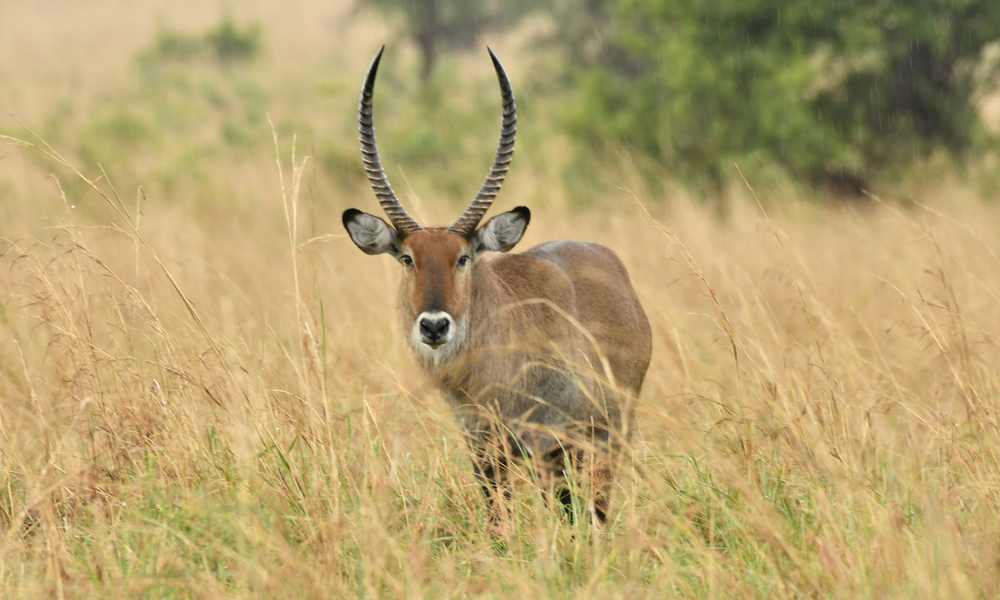For wildlife safaris in Rwanda, Akagera National Park is one of the most well-liked parks. Located in eastern Rwanda, adjacent to Tanzania’s border, Akagera National Park spans 1,200 km². The three eco-regions, savannah, mountain, and swamp, were the focus of its 1934 founding, which aimed to safeguard the fauna and flora there. Lake Ihema is the largest of the park’s multiple lakes, with the Kagera River flowing along its eastern border and giving rise to the park’s name. Encompassing more than one-third of the park, the intricate network of lakes and interconnecting papyrus swamps represents the biggest protected wetland in central Africa.
The 970 km² Nyungwe Forest National Park was created in 2004 and is home to grasslands, bogs, bamboo forests, and wetlands. The closest town is 54 km to the west, in Cyangugu. There is Mount Bigugu inside the park boundaries.

Things to see in Akagera National Park.
Above all, Rwanda’s Akagera National Park is home to many of large game! Elephant and buffalo herds come out of the forest to drink at the lakes, and tourists who are lucky enough may encounter a wayward lion, spotted hyena, or perhaps a leopard. The savannah is home to giraffes and zebras, while the park is home to over a dozen different species of antelope, including the world’s largest antelope, the Cape eland, and the attractive chestnut-coated impala.
Throughout the day, more than fifty hippopotami pods sputter and grunt, while enormous crocodiles bask in the sun, their enormous mouths hanging open dangerously. Then, as if by magic, the air is split apart and the iconic pair of fish eagles declares their dominance over the waterways of Africa. Some of the densest concentrations of water birds on the continent can be seen lining the lakes. The unique shoebill stork, possibly the most sought-after African bird, and the rare and magnificent papyrus gonolek can be found in the interconnecting wetlands.
Things to do in Akagera National Park
Boat Cruise on Lake Ihema
On Lake Ihema, boat tours are offered and are well worth the journey. Reservations should be made in advance. You’re likely to come across sizable breeding colonies of African darter, cormorant, and open-bill stork, as well as up close encounters with enormous pods of hippos and crocodiles. Other aquatic birds abound: pied kingfishers hover high above the water to swoop down on their fishy prey, fish eagles are stationed in the trees at regular intervals, and the delicate and colourful African jacana can be seen trotting on floating vegetation. For enthusiasts, seeing marsh specialists like blue-headed coucal and marsh flycatcher will be of more interest.
Wildlife Game Drives
There are game drives available; if possible, you should have a 4×4; otherwise, you must stay at the lodge. There is no additional cost for the guides, who will assist you in navigating the area. Essentially, the game-viewing circuit is confined to a single main road that extends northward from the park headquarters situated at Lake Ihema. This road either passes by or offers access to the majority of the lakes via a short fork. The road splits into two main directions north of Lake Hago, one of which goes west into the Mutumba hills. The park can only be accessible in the vicinity of Lake Ihema and the Game Lodge, which limits the options for game drives. You might reasonably make the trip from the entrance as far north as the Mutumba Hills and back in a whole half-day.
It takes the better part of a day to travel farther north. Alternatively, take the exit-only route that leads north of Lake Rwanyakizinga and emerges onto the major tar road that leads to the Ugandan border. Only with the assistance of a guide should one attempt the extremely hazy routes in the far north. After returning to the main road, the guide can be left off at the intersections of Kayonza or Kabarondo, provided he has enough cash to take a motorbike taxi back to the headquarters. A mountainous road that travels through dense brush begins at the entrance gate and travels for approximately 5km to reach Lake Ihema. It’s on an island close to Ihema’s eastern shore, where it’s humid and full of mosquitoes.
Where to stay in Akagera National Park
Within the 90 000 hectare Akagera National Park, in the northeast of Rwanda, is the Akagera Game Lodge. It is situated in the province’s eastern region. The spectacular Akagera Game Lodge is perched above a ridge with a view of Lake Ihema, surrounded by a patchwork of grass, shrubs, and a diverse landscape featuring hills, deep valleys, lakes, and marches. Akagera National Park offers more affordable amenities.
How to get to Akagera National Park
By public transport, it takes two hours to go to Akagera from Kigali and roughly an hour to get there from Kibungo or Rwamagana. The major surfaced road at Kabarondo, 15km north of Kibungo, splits off into a 27km dirt road that leads to the only useable access gate, 500m from the recently constructed Akagera Game Lodge. All vehicles can travel on this fair-condition dirt route, with the exception of rainy days. A 4×4 is recommended inside the park, though any car with adequate clearance should be fine during the dry season.
